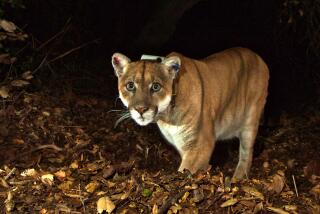L.A.’s mountain lions could be near extinction in 50 years
Mountain lions living in Greater Los Angeles could be at risk of extinction within the next 50 years if the population remains isolated by freeways and other forms of human development, UCLA and National Park Service wildlife ecologists are warning.
About 15 pumas survive in the Santa Monica Mountains, cut off from the rest of their species by a host of man-made obstructions. With almost no new cats able to enter the area, the gene pool among local lions has stagnated — and without more genetic diversity, they will be vulnerable to extinction.
In a study published this week in the Proceedings of the Royal Society B, wildlife ecologist John Benson of the UCLA La Kretz Center for California Conservation Science and his colleagues used 13 years of tracking and genetic data from the National Park Service to estimate the odds that the mountain lions will survive long term in the Santa Monica range.
The results offer good and bad news for the big cats, which inhabit a 150,000-acre region bounded by the 101 and 405 freeways to the north and east and agricultural fields in Oxnard to the west.
See the most-read stories in Science this hour »
First the good news: The population is currently stable and even shows some potential for growth in the next 25 years or so.
But the long-term prognosis is much more uncertain.
The mountain lions face a moderate 15% to 22% risk of extinction because of their small population size and geographic isolation alone. Unlike a larger population that is buffered against the threat of being wiped out by a chance occurrence, a single death among the 15 pumas could have significant consequences for the animals. In the Santa Monica Mountains, two male lions dominate most of the breeding.
“If it just so happens one month that one gets hit by a car and one dies of rodenticide poisoning, then all of a sudden you’re out of males,” said study coauthor Seth Riley, a wildlife ecologist for the park service, which manages the Santa Monica Mountains. Human development, including the 10-lane 101 Freeway, makes it very difficult for new males to migrate in to the region.
There’s also the risk posed by inbreeding. As scientists have observed for years, the pumas often resort to mating with close relatives. If that continues, genetic deficiencies will arise in the population and affect the animals’ abilities to reproduce and survive — a phenomenon called inbreeding depression. When the study authors factored this threat into their calculations, the risk of extinction became a near certainty, rising to 99.7%.
Wild panthers in Florida were in a similar situation 20 years ago. Because of overhunting and habitat loss, the panthers became isolated within a single region of swampland. The population fell to just 20 to 30 individuals until wildlife officials took emergency action and imported panthers from Texas to Florida. The population soon rebounded to hundreds of animals.
For scientists in California, the panthers offer a cautionary tale.
The mountain lion population in the Santa Monica Mountains is still relatively healthy but has the lowest documented genetic diversity of any puma population, aside from Florida’s panthers. Scientists now have a chance to tackle the main threat to the big cats’ survival: isolation.
“The habitat we do have in the Santa Monicas is pretty good: they’re finding enough deer to eat and they’re eating and they’re staying out of major conflicts with people,” Riley said. “But the area is just too small, genetically and demographically.”
The National Park Service has kept close tabs on the mountain lion population in the Santa Monicas since 2002. In that time, only one newcomer, known as P-12, has ventured in to the area.
In 2009, the young male crossed the 101 Freeway from the Simi Hills into the Santa Monicas and bred with a female. Eventually, though, he began mating with his daughters and granddaughters — undoing any benefits to the population’s genetic diversity.
The episode highlights the need for a wildlife corridor to allow mountain lions — and all sorts of other wildlife — to enter and exit the Santa Monica Mountains, the study’s authors said. Last year, Caltrans proposed building a 165-foot-wide, 200-foot-long bridge over the 101 Freeway near Liberty Canyon Road in Agoura Hills that would connect the Santa Monicas with the Simi Hills and adjacent Santa Susana Mountains.
If even one new mountain lion crossed over into the Santa Monica Mountains every few years, that would be enough to avoid inbreeding depression and lower the risk of extinction to below 3%.
“It doesn’t have to be all that much,” Riley said. “You don’t need a whole parade of lions coming across the freeway.”
Building the passageway, estimated to cost $33 million to $38 million, might eliminate the need to physically relocate mountain lions from other habitats to the Santa Monica Mountains, the study authors wrote. It would also benefit bobcats, coyotes, western fence lizards and a small bird species called the wrentit that have also shown significant genetic differences on either side of the 101 Freeway.
“The beauty of having a crossing is animals can come across indefinitely,” Benson said. “Any animals that may need a way to cross the freeway can do so, and we can help the whole ecosystem instead of just a single species.”
Follow me on Twitter seangreene89 and “like” Los Angeles Times Science on Facebook.
MORE IN SCIENCE
3.2 million years after her death, autopsy reveals that ‘Lucy’ died of devastating fall from tree
Pediatricians urge states to get tough on parents who don’t want to vaccinate their kids
Meet Octobot, a soft-bodied robot that moves like an octopus







